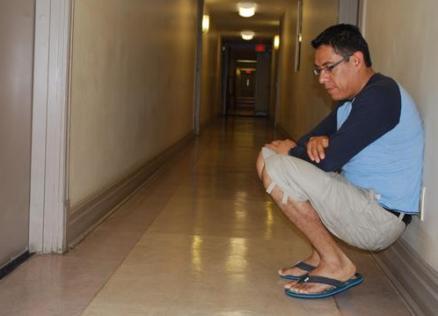Paramedics misapplied their own emergency response protocols when they decided to wait around the corner from 40 Alexander St, where James Hearst lay dying in the lobby, instead of rushing to his aid, a coroner’s inquest into his death was told Feb 15.
Hearst, who was gay, died of a heart attack on June 25, 2009, in the lobby of his apartment building after he waited 38 minutes for paramedics to arrive, despite three calls to 911 from bystanders and a building security guard. The incident happened in the midst of a civic workers’ strike; it later emerged that paramedics were “staging” their response around the corner while they waited for police to arrive.
One of the two paramedics initially dispatched to the scene faced heavy questioning about his and his partner’s decision to “stage” their response to a 911 call placed by a building resident. Rather than going directly to the scene, they parked their ambulance and waited at the corner of Yonge and Alexander streets, out of sight of the building without their lights on.
While the expected response time to an emergency call is 10 minutes and 59 seconds, paramedics took 38 minutes to arrive on scene. Two more 911 calls were made in that time.
The inquest had previously been told that the 911 dispatcher who took the initial call had miscategorized the emergency as “unknown trouble” rather than “a fall” and reported that Hearst “had been drinking,” when the caller actually said he’d fallen over and “it looks like he [Hearst] might be drunk.”
The distinction raised a red flag in the dispatch system that automatically alerted police to go to the scene, both because it was “unknown trouble” and because drunk patients are believed to present a possible safety hazard.
The paramedic testified that he didn’t notice the “had been drinking” note but was cautious because of the “unknown trouble” note and the police call.
“We had concerns because we thought this was a possible assault,” he said. “I thought assault was likely because the police were notified. I was not aware that police are notified on all unknown calls.”
Coroner’s counsel Stefania Fericean asked the paramedic if he truly believed that an assailant would still be on site 30 minutes after an attack, with the patient not moving and building security on site.
“It’s improbable but possible,” he said. He told the court that the decision to stage on Yonge St was made so that they would see police coming and that they expected police to approach from Yonge St as Alexander is one-way. He also said they were concerned that staging on Alexander St itself would be dangerous because they were unsure if the lobby of 40 Alexander came directly to the sidewalk, which would put the vehicle close to the potentially dangerous situation.
Under questioning from Emtiaz Bala, counsel for the Ministry of Health and Long-Term Care, the paramedic admitted that if they had looked up Alexander St, they would have seen that not a single building on the street comes right to the sidewalk. He also noted that he didn’t consider the fact that several pedestrians and cyclists walked or rode past the building during that time without any danger.
The paramedic said that the call had been classified initially as a “Bravo,” or lower-priority call. When the call was upgraded to the more serious “Echo” level, he said, he and his partner panicked. It took an additional 82 seconds to begin to drive to the scene. When they arrived, they had to wait a further minute and a half for a firetruck that had responded immediately to the Echo call to clear the driveway.
The fire truck came from the station on Grosvenor St and crossed directly in front of the parked ambulance, but the paramedic told the court that neither he nor his partner noticed.
The paramedic denied that the civic workers’ strike that was ongoing that night affected his response to the call.
“Absolutely not,” he said. “This particular evening was no different than any other evening for me.”
Under questioning from Fericean, he denied that he had intentionally slowed his responses to calls either independently or as part of a work action.
Fericean pointed out that, according to the EMS protocol, the proper response to a call where the paramedic believes there may be risk is that they are to arrive on the scene and check for safety concerns before deciding to stage.
Since Hearst’s death, EMS has issued a new protocol relating to staged responses. Under the new protocol, paramedics must go as close to the scene as possible and use reasonable judgment based on specific information when determining to delay patient care. Before they decide to stage patient care, they must fill out and sign a form detailing why.
The new protocol has led to an 82 percent drop in the rate of EMS calls being staged by paramedics.
After making such grave errors on the Hearst call, the paramedic told the coroner’s court, “I’ll remember my staging protocols forever.”
The inquiry will take a brief hiatus of at least one week after Feb 17 and will then resume for at least two more weeks. Xtra continues to follow this story.


 Why you can trust Xtra
Why you can trust Xtra


